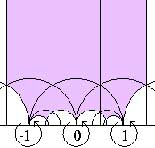
Rather than going to the NOG
III Workshop I think it is more fun to give a talk for the Capita
Selecta-course for 2nd year students on “Monstrous Moonshine”. If
I manage to explain to them at least something, I think I am in good
shape for next year\’s Baby Geometry (first year) course. Besides,
afterwards I may decide to give some details of Borcherds\’ solution next year in my 3rd year
Geometry-course…(but this may just be a little bit
over-optimistic).
Anyway, this is what I plan to do in my
lecture : explain both sides of the McKay-observation
that
196 884 = 196 883 + 1
that is, I\’ll give
the action of the modular group on the upper-half plane and prove that
its fundamental domain is just C using the modular j-function (left hand
side) and sketch the importance of the Monster group and its
representation theory (right hand side). Then I\’ll mention Ogg\’s
observation that the only subgroups Gamma(0,p)+ of SL(2,Z)
for which the fundamental domain has genus zero are the prime divisors
p of teh order of the Monster and I\’ll come to moonshine
conjecture of Conway and Norton (for those students who did hear my talk
on Antwerp sprouts, yes both Conway and Simon Norton (via his
SNORT-go) did appear there too…) and if time allows it, I\’ll sketch
the main idea of the proof. Fortunately, Richard Borcherds has written
some excellent expository papers I can use (see his papers-page and I also discovered a beautiful
moonshine-page by Helena Verrill which will make my job a lot
easier.
Btw. yesterday\’s Monster was taken from her other monster story…
 Writing a survey paper is a highly underestimated task. I once
Writing a survey paper is a highly underestimated task. I once